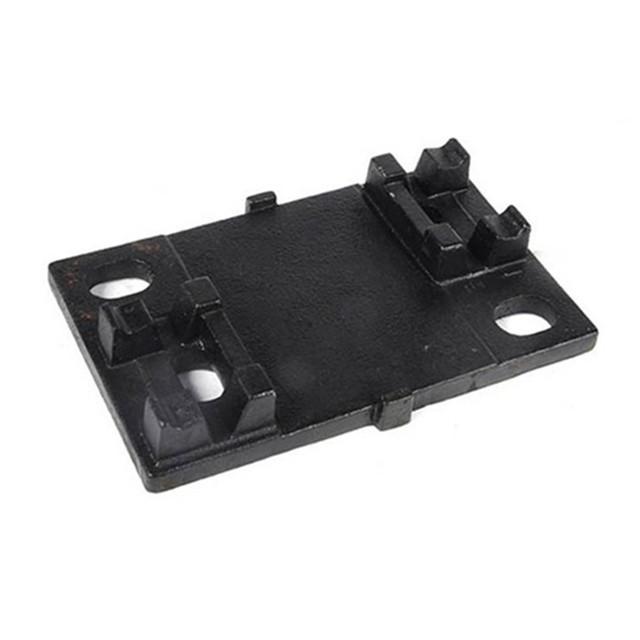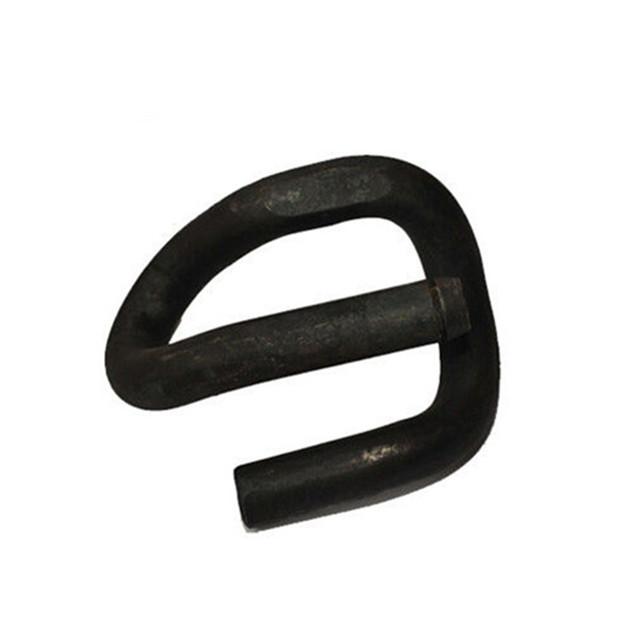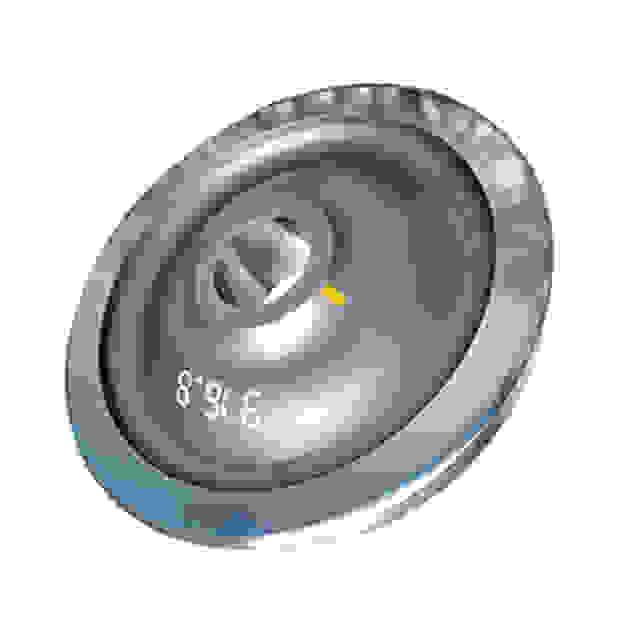

Rail Tie Plates for concert sleeper
Other Products
A tie plate is also called a baseplate or sole plate. Ruika specializes in producing rail fastening and tie plate is one of our main products. Rail tie plate is used in rail construction to support the rails. We can offer rail tie plate made using either casting iron or casting steel for customers to choose from, depending on the load and the type of rails. Boltable as well as rail clips can be applied. For the discontinuous type of support, we supply various ribbed tie plate which are also produced in casting iron or casting steel.
Tie plates are generally used to take the load of rail and distribute the load to the sleepers offering proven economies. We manufacture all types of base plates suitable for various rail sections, for use on wooden, steel or concrete sleepers and ballast-less tracks used with elastic fastenings on wooden sleepers and 'K' type fastening system.
|
Product name |
Type |
Process |
Material |
|
Railroad Tie Fasteners |
Single Shoulder |
Rolled,Forging,Casting |
QT450-10,20#,35#,etc |
|
Railroad Tie Fasteners |
Double Shoulder |
Rolled,Forging,Casting |
QT450-10,20#,35#,etc |
|
Railroad Tie Fasteners |
No Shoulder |
Rolled,Forging,Casting |
QT450-10,20#,35#,etc |
|
Other kinds of baseplate are also available according to your drawings or samples! |
|||
Tie plate or sole plates are needed in rail installation, as they not only support the rails, but also enable the entire fastening system to be fixed on. Rail tie plates are the uppermost component of a crane rail or track support system. The primary function of a tie plate or sole plate is to provide the rail with a flat, smooth resting surface while allowing for vertical alignment of the rail system. Tie plates are secured by Anchor Bolts, also known as Holding Down Bolts. Soleplates are typically installed with a layer of grout cast beneath, which fills the void between the soleplate and the concrete foundation.
The holes for bolting the anchor and leveling bolts, and holes for bolt through clips if present, are precisely drilled into the sole plates. For weldable clips and base clips, the bottom of the clip is welded onto the sole plates before galvanizing.
Cast iron can be the welded or fabricated type, depending upon the customers requirements. Our rail tie plate can be made to suit various rail section, i.e. UIC 60, UIC 54, RN 45, 90 A, etc.
At our production base for the tie plates, various types are available following standards of AREMA, UIC, BS and others, with either single shoulder plates or double shoulder plates according to customers’ requirements.
For the processing way, casting used to be most popular for both China and abroad. However, in recent years, rolling technology is rising up to produce tie plates in China, due to increasing such orders from international clients, especially America and Canada. Our company is the first company in China to try rolling processing onto baseplate production, based on our available rolling steel expertise, used for rail joint bar and gauge blocks. Up to now, we have successfully made out dies for rail tie plates for 11inches, 14inches and 14-3/4inch for both 5-1/2 and 6inch rail bases. Some more varieties are under negotiation with the clients as well. Based on this, we received 3 orders for rolling tie plates with total weight over 3,000tons.
Of course, tie plate production by casting and forging are also available at our company.
Types of railway tie plates we produce vary from 2holes, 4holes, 5holes, 6holes, and 8holes.
Size: 10-15inch long, for rails of 90RA-A, 100RE, 115-119RE, 132-136RE
Material: Low carbon steel/high carbon steel, equivalent of customers’ required materials.
Standard: AREMA
Processing way: casting, forging or rolling
Size: for UIC60, UIC54, S48 rails
Material: Low carbon steel, high carbon steel, casting iron.
Standard: UIC864-6
Processing way: casting, forging or rolling
Size: for 50kg/30kg/37kg rails
Material: QT450-10 or other low carbon steel
Standard: GB, JIS E1110
Processing way: casting, forging or rolling
Size: P50
Material: Material: QT450-10 or other low carbon steel
Processing way: casting, forging or rolling
Adhering to our quality first policy, Ruika pays great attention to quality control management on our tie plate. We have been granted ISO9001-2008 certificates and have received the production license of China's Railway Ministry on railway products. We have a full set of inspection instruments to ensure all our rail tie plates are of high quality and up to customers' requirements.
As a leading manufacturer of rail fastening based in China, Ruika also produces many other railway fasteners, such as track bolt, sleeper screw, rail joint bar, rail anchor, rail clip, elastic rail clip, SKL tension clamp, rail shoulder, and so on.
A: We are a factory.
Q: How long is your delivery time?
A: Generally within 25-30 days for a 20ft container after the prepayment received.
Q: What is your terms of payment ?
A: 30% of the payment in advance , the balance before shippment via T/T.
Q: Will that be possible for us to receive pieces of samples for approval?
A: Sure. The samples can be supplied for free but the freight counts on you.
Q: What's the packing way?
A: Bundled in steel strips with iron/wood pallets.
Q: How long will it be the quotation valid?
A: The validity is 15 days in general, but also depends on the quantity and special conditions. It will be shown in every quotation.
Q: What is MOQ?
A: 20’’ container in general, depending on whether enough stocks available for small quantity; customized products accepted.
Q: Do you have any certifications regarding rail tie plates?
A: We have passed the certification of CRCC in China and ISO9001:2008 overseas. Before shipment, Certificate of Quality can be supplied. We also accept Third Party Inspection from clients, with free samples to supply.
If you have any questions, pls feel free to contact us as below:
Wechat: +86 15215554137
Web: http://www.kirail.com/
Email: kelly(@)kirail.com
| Industry Category | Transportation/Train-Parts |
|---|---|
| Product Category | |
| Brand: | |
| Spec: | |
| Stock: | |
| Origin: |





